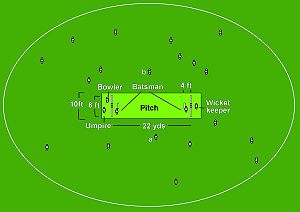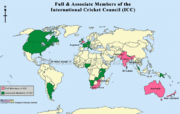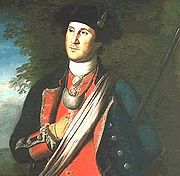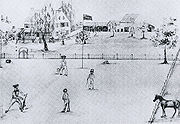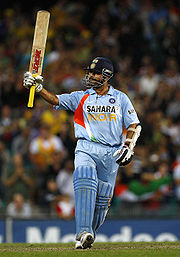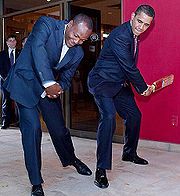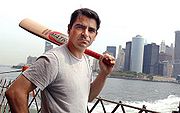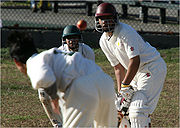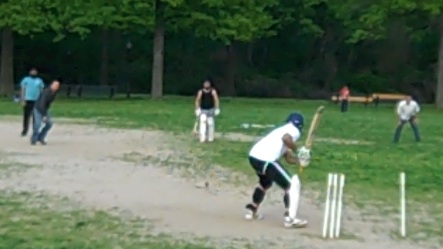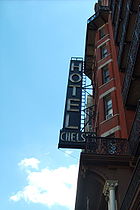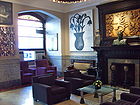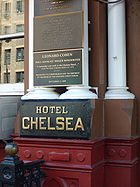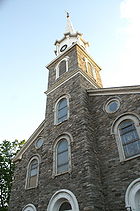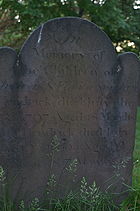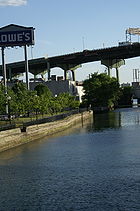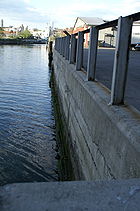From The Peopling of New York City
Contents |
Cricket
Rules and Regulations of Cricket
Here is a short video explaining some rules and roles:
The game of cricket is played like most sports game: with two teams facing off. Each team has eleven players, as well as a backup player, called a “twelfth man.” The twelfth man's only function is to substitute for another player on the grounds of injury. In addition, there are usually three umpires. The two on the field make decisions, and the third is in charge of video decisions, which occur when the call is too close for the field umpire to decide.
The players play cricket on a grassy field. Located in the center of the cricket field is the pitch, which is a flat turf that measures 22 yards in length. There are three stumps at each end of the pitch, and at each end the three stumps are connected by two bails on top of the stumps. The three stumps and two bails put together are called a “wicket.” About 4 feet from the wicket, is the base where the batsman stands to bat.
There are four main positions in cricket: batsman, bowler, fieldsman, and wicket keeper. This is similar to America's favorite pastime, baseball. The batsman is similar to a batter in baseball where he stands on the base with two batsmen on the field, one on each end, always. The batsman's purpose is to hit the ball and run between the wickets up to four or six times per bowl. The bowler is similar to that of a pitcher and his job is to bowl the ball to hit the wicket and essentially, make it as hard as possible for the batsman to score runs. The fieldsmen are similar to the fielders and they are there to catch the ball after it has been hit or bowled and to stop it from going out of the boundary. The wicket keeper is similar to the catcher and his job is to stand behind the stumps and to stop the ball from passing him.
The purpose of this game is to score the most runs. A run is scored when a batsman either reaches from one end of the pitch to the other or if he bats and the ball reaches outside of the boundary. In order for a run to be scored both of the batsman have to reach the opposite ends of the pitch. If a batsman hits the ball outside of the boundary, they either get four (if the ball touched the ground) or six (if the ball did not touch the ground) runs. In addition, if the batsmen physically run more than four or six times (depending on the rules) any more runs are considered null and void.
Sources:
"An Explanation of Cricket - What Is Cricket." Abc of Cricket. Web. 09 May 2010. <http://www.abcofcricket.com/cfb1/cfb4/cfb4.htm>.
History of Cricket
Cricket is a very old game that is thought to have originated during the Dark Ages somewhere in Northern Europe. Most of the history of how cricket changed from being a simple game where one player bowled an object and the other hit it with a club into what we know today is shrouded in mystery. However, it is agreed upon that by Tudor times (1485-1603) cricket had finished it’s evolution into the game we know today. Within a few years the game became a leisure activity at schools in Kent, Sussex, and Surrey, and became popular enough among the younger generations to earn the disapproval of local magistrates. [1]
As we know, cricket is a sport played all around the world. There are currently 104 countries in the game’s governing body, the International Cricket Council (ICC). [2] In addition, cricket is currently the world’s second most popular sport around the globe. [3] [4] However, we may wonder, how did cricket spread so quickly and diversely?
Currently cricket is acknowledged as the official sport of England. [5] In fact, it is through the British Empire that cricket spread worldwide. Essentially, British imperialism carried the sport all over the world. Additionally, the first international match was held in 1844 between Canada and the United States. [6]
It is no wonder that countries such as India, the West Indies, and South Africa enjoy playing cricket, considering they were all former British colonies. According to Habibul Haque Khondker, “Cricket for the British was a tool for civilizing the colonial subjects by spreading the values of Victorian morality and character building.” [7] Another interesting fact to note is that, “Cricket was seen as an ideal way to socialize natives [who were perceived as lazy, enervated, and effete] into new modes of intergroup conduct and new standards of public behavior.” [8]
Cricket was so popular in these countries that even after decolonization, the former colonies continued to play the sport. While one would think that they would shun the systems in place because of colonialism, most of them had actually retained a lot of their colonial background, including democratic institutions and as we know, the sport of cricket. [9]
In his book Beyond A Boundary, C.L.R. James says, “I haven’t the slightest doubt that the clash of race, caste and class did not retard but stimulated West Indian cricket. The class and racial rivalries were too intense. They could be fought out without violence or much lost except pride and honour.” As previously noted, cricket civilized the colonies, allowing them to experience a respect for the laws, a control of emotions, and a sense of loyalty.
When the cricket loving immigrants came to the United States, they brought the sport with them and continue to play today.
Sources:
"Cricinfo.com." Cricinfo.com | Cricket News, Live Scores and Statistics. Web. 09 May 2010. <http://www.cricinfo.com/ci/content/story/239757.html>.
Doley, Amrit. "The World's Top 10 Most Popular Team Sports - Sportingo." Sports News and Sports Headlines | Sports Site | Latest Sports Views from Real Fans - Sportingo. Web. 09 May 2010. <http://www.sportingo.com/all-sports/a11587_worlds-top-most-popular-team-sports>.
James, C. L. R. Beyond a Boundary. Durham: Duke UP, 1993. Print.
Khondker, Habibul Haque. Cricket,Colonianism, Culture, and Cosmopolitanism. Thesis. National University Of Singapore. Print.
"Sports in England « Great Britain." Great Britain. Web. 09 May 2010. <http://england.costasur.com/en/sports.html>.
Williams, Timothy. "Playing a Sport With Balls and Bats, but No Pitcher." The New York Times - Breaking News, World News & Multimedia. The New York Times. Web. 08 May 2010. <http://www.nytimes.com/2008/04/03/nyregion/03cricket.html?_r=1>.
Cricket in Pakistan
Without toilets in Spring Creek Park and safe benches in Cunningham Park, Pakistani Ijaz Ahmed Qureshi had one thing to say, "Let's move to England". He says this because he lives in Long Island and must travel out to Brooklyn or Queens just to play cricket -- even then, conditions aren't as enjoyable. With family living in Bradford, West Yorkshire -- also known as "Bradistan" or "Mini Pakistan", Qureshi describes the various cricket leagues in the one town and the large number of cricket fields. He jokes, however, "The weather isn't as great as New York's or Pakistan's though. I guess I should move back to my little village and play in the fields". In Pakistan's larger cities of Islamabad, Karachi, Lahore, and Rawalpindi, Pakistanis play in cricket stadiums wearing proper attire; but, this doesn't account for the majority of Pakistanis. Villagers, like Qureshi play in Shalwar Kameez, sometimes wearing shoes and not sneakers, playing in the wheat fields with other men in the village. "Main aakhna aah je main Pakistan vaapis jaa, lekin utheh kam ni milnaa. Cricket kheraa ya kam karaa? Maari kismat vich kam likhi vi", the Mirpuri-speaking Pakistani says. When translated, Qureshi joked, "I would return back to Pakistan but you can't find jobs there. Shall I play cricket or work? I'm destined to work"; he says this as a father of a two-year old and the youngest son of five children -- he must send money back home to his family.
When the World Cup would be taking place, people of his village would get together to watch it in a cafe since most didn't have cable television in their homes. Nearly every Pakistani knows the scores of Cricket games -- unlike the Pakistanis in America, who are only knowledgeable of Baseball, Tennis, Basketball, or Football. Dedicated heavily to Cricket and Rugby, Pakistan's cricket stadiums are huge; the smallest ones have the capacity of holding 5000, while the largest ones have the capacity of holding over 48000 people. While matches are held in Pakistani stadiums, no World Cup matches have in the past decade. In the 2010 World Cup, for example, all of the matches are held in South Africa. Mirpur, an economic district in Azad Jammu Kashmir also has its own stadium - the Quaid-I-Azam Stadium, with tickets costing from 250 rupees up to 2500 rupees ($3 to $30).
Immigrants in New York can afford the priciest tickets because they work, however, they have no stadium to watch a professional cricket game in. According to the Cricket Organization of America, by 2012 the U.S. should have its own professional test cricket team -- based in Florida, where the team would have its own stadium and state-of-the-art facilities to train.
Pakistan's recent establishment of a Women's Cricket League, in 1997, further proves how popular cricket has become -- allowing women to play a sport in a male-dominance country; regulated by the Pakistan Cricket Board, the women aren't as widely known as the Men's national team.
Will Shahid Afridi or Younis Khan come from Pakistan to play in Florida where there are fewer than 1000 cricket fans? A cricket stadium in New York would have been more ideal, as it would be stationed near little India (Jackson Heights) and the heavy South Asian community.
History of Cricket in America
Despite its short-lived American legacy, the game of cricket has a history in the United States that would surprise even the most devout of cricket fans. Since its introduction by British colonists almost three hundred years ago, cricket has seen its highs and lows in this country. Following its earliest reference in the 1709 diaries of William Byrd,[10] the game’s appeal in America was initially, steadily on the rise. Several states along the eastern coast of America had in fact formed their own cricket teams that competed not only on a domestic level, but also internationally, with other states/cities around the world. In a match played in New York City in 1751, the XI of New York went as far as defeating their counterparts, and pioneers of the game, XI of London. Coverage of the game in newspapers and journals further enhanced its appeal in the eyes of the public. Match reports and scorecards of games in newspapers such as the New York Weekly Post Boy, and advertisements of cricketing equipment in the New York Independent Journal helped create public awareness of the game.
Unlike today, cricket in America has not always been an immigrant’s sport; the gentleman’s game, true to its name, caught the eyes of some of the greatest gentlemen of this country. George Washington and John Adams were two of the many presidents who took to the game as a pastime.[11] There is evidence suggesting that George Washington's troops played a version of cricket at Valley Forge in 1778. In addition, President Lincoln is said to have attended the 1859 cricket match between Chicago and Milwaukee.[12] In fact, it is even thought that Benjamin Franklin contributed to the formalization of the rules of the game, when in 1754 he brought to
America a copy of the “London Method,” the 1744 Laws, which contained the official rules of the game.[13] [14]
The success of Philadelphia Cricket Club, one of the oldest clubs in the country founded by young men of English descent,[15] marked the “Golden Age” in the history of American cricket, when it went on to become the country’s national sport.[16] It was then that the US national team even participated in cricket’s first international game against Canada. Although controversial, this game at Bloomingdale Park, Manhattan in 1844 drew close to 20,000 supporters, and is considered to be the world’s first international sporting rivalry.[17]
Despite the promising start, cricket’s success in America was short lived. With the onset of baseball, fans ditched one bat and ball sport for another- faster-paced, probably less “girly” sport. The anti-British emotions stemming from the Revolutionary War allegedly further contributed to the sport’s decline.
With so much of the game’s history embedded in American culture, cricket’s present status in this country is truly a pity. However, with its ever-expanding horizons, the future of cricket in America once again looks bright.
Sources:
Byrd, William. The Secret Diary of William Byrd of Westover. Richmond: Dietz Press, 1941.
Marder, John and Cole, Adrian , "Cricket in the USA". ESPN Cricinfo. April 27, 2010 <http://www.cricinfo.com/usa/content/story/261614.html>.
Marshall-Dutcher, Joan. "The Winter At Valley Forge". The American Revolution Homepage. May 5, 2010 <http://americanrevwar.homestead.com/files/VALLEY.HTM>.
Murdoch, Joseph S.. "Philadelphia Cricket Club History". The Philadelphia Cricket Club. May 1, 2010 <http://www.philacricket.com/Default.aspx?p=DynamicModule&pageid=301883&ssid=186953&vnf=1>.
Singh, Amar. "Cricket In America". The C.C Morris Cricket Library and Collection. May 5, 2010 <http://www.ccmorris.org/site_update/Cricket_In_America.htm>.
Williamson, Martin. "The oldest international contest of them all ". ESPN Cricinfo. May 1, 2010 <http://www.cricinfo.com/usa/content/story/141170.html>.
Worrall, Simon. "Cricket Anyone?". Smithsonian. April 25, 2010 <http://www.smithsonianmag.com/people-places/cricket.html?c=y&page=1>.
Cricket in New York City
by Zerxis
From Afghanistan to Zimbabwe, the game of cricket is increasingly changing the millions of lives it touches each year. Cricket, in nations like India, is more than just a game, it is a way of life; people in such nations eat, sleep, and drink cricket.
So what happens when thousands of cricket aficionados immigrate each year to non-cricketing nations like America? Are they quick to leave behind this seemingly inseparable part of themselves and their daily rigmarole?
The answer according to Sanjay Joseph, a seventeen year old immigrant from India, is no. Cricket, according to him, stamps onto its supporters a love and passion for the game that is hard to ever erase. Therefore, wherever a cricketer goes, he takes with him his companion and prized possession; his cricket bat.
With well over 300,000 New York City residents tracing their origins to nations of the Indian subcontinent such as India, Pakistan, Bangladesh and Sri Lanka, finding a cricket fan in our diverse city is not difficult. Despite the game’s relatively subservient status in the American sporting scene, cricket’s appeal is today steadily on the rise. The New York City park system is testimony to this increasing popularity of the game. A visit to the Van Cortlandt Park, Kissena Park, or the Ferry Point Park will show you glimpses of the great “gentleman’s game.” Today, the sport is slowly being incorporated at the varsity level, as schools such as the Bronx High School of Science are creating their own cricket teams with players and coaches to compete with other New York City public schools.
Cricket as a symbol of New York City
One of the many reasons why New York is called the melting pot of the world is that immigrant’s who come to this city, introduce customs and practices that are foreign to New York, while they simultaneously absorb what it has to offer them. The addition of cricket to New York is not only changing the city’s sporting culture, but also the way immigrants settle down and enjoy their lives. Today's cricketing fans no longer need to learn an American sport such baseball upon arriving here. Visiting some of the above-mentioned parks will provide them a new sporting option; cricket.
Although cricket’s basic rules remain the same regardless of where it is played, several modifications have been made in terms of how the game is played, that further exemplify the melting pot phenomenon of this city. Cricket in India is usually played with either a rubber ball or a hard ball made from leather and cork. In America however, after playing alongside Pakistanis and West Indians, Indians have started using a much lighter, “tape ball” that is seldom used in India. In addition, in New York unlike back home, we often see Indians and Pakistanis take a long run-up before releasing the ball in an “under-arm” motion. This style has been probably learnt after coming to New York, once again, by playing alongside the West Indians, amongst whom this practice is prevalent.
Modern technological advances such as the television and the computer further provide present day cricket lovers in America luxuries that immigrants of the past were deprived of. Today, through the services of peer-to-peer (P2P) internet applications, and cricket broadcasters such as Dish Network, DirecTV and Willow TV, American cricket fans not only get to watch their mentors such as Sachin Tendulkar and Brian Lara, but also get to support their beloved national teams. Thus, despite being miles away from home, a cricket fan’s bond and love for his/her motherland continues to grow.
Cricket in New York is more than just entertainment for the fans. The game epitomizes the very essence of this great city, by uniting cricket lovers from the world over. Like most New Yorkers, cricketers in this city have learned to overlook racial and ethnic differences, in an attempt to forge a bond with those who share their passion for the game far away from “home.” In New York, unlike most other cities in the world, it is therefore commonplace to see an Indian and a Pakistani, in the same team, hugging each other, or giving “high-fives” after hitting a boundary or taking a wicket.
In his novel, Netherland, Joseph O’Neill expresses this sentiment by mentioning how cricket was introduced to Papa New Guinea’s Trobriand Island in a bid to reduce the civil violence and killing. The game, with its rules and umpires, was “a crash course in democracy” making the islanders respect those they played with, despite being their enemies. Cricket in New York similarly promotes tolerance and develops relationships by providing conflicting groups such as Hindus and Muslims something in common. In June 2009, the NYPD even organized a cricket competition to strengthen its relationship with the city’s immigrant communities.
Sources:
O'Neill, Joseph. Netherland. New York: Pantheon Books, 2008.
Changes in our Parks for Immigrants
Over forty percent of New York City’s population is foreign born. Of these forty percent, the majority are cricket fans but must concentrate in a mere fourteen parks to play cricket among the 1700 parks, playgrounds, and recreation facilities that are scattered in the five bureaus. Immigrants from South Africa, Guyana, Pakistan, India, and Bangladesh rallied for a bigger cricket field and their wishes came true. With the help of “Parks for All New Yorkers: Immigrants, Culture and New York City Parks,” by New Yorkers for Parks, a nonprofit advocacy group, the immigrants pleaded to Adrian Benepe, commissioner for the city’s Department of Parks and Recreation and got their plans approved. In 2003, City Parks & Recreation funded and built New York’s first cricket field - in Brooklyn’s Spring Creek Park.
The cricket patterns, however, are hard to explain as no one can predict if future generations will be cricket as cricket has yet to become a sport played in schools. Mohammed Iqbal, 16, a senior at Midwood High School in Brooklyn, said he had played cricket in Lahore, Pakistan, before moving to the United States.“People don’t play it here and don’t know the rules of the game. If you want to play it, you have to makes sure you’re playing cricket with another immigrant – someone who understands you” he said.
The New York City Police Department established a cricket competition for young men in 2009 - with 10 teams and 170 players this year. A cricket match can last as long as five days and still end in a tie. However, the Police Department has adopted a shorter form of the game, called Twenty20 — in this form, a match lasts around three hours. The league’s matches are played at Spring Creek Park in Brooklyn and Kissena Park in Queens.
Cricket in Kissena Park
Kissena Park is located less than 20 minutes away, on foot, from Mainstreet Flushing, Queens, where many immigrants and their children from Afghanistan, India, Pakistan and other nations within the region live. While the children in these families attended high schools and middle schools in the area and avidly participated in popular “American" sports such as basketball, volleyball, tennis, football and softball, many of them also have a passion for a sport that is much less recognized by the majority of Americans, cricket. Kissena Park is one site near Flushing where these children enjoyed this game.
A modest plot of the park, the intersection between Kissena Boulevard and Rose Avenue, hosted 4 fan shaped baseball fields (shown in bottom of text). Although the fields are often occupied by baseball players, cricket is also a popular game played on these fields. Children and adults of south Asian heritage, many belonging to the Indian Sikh community, engage in friendly yet excitingly competitive games that attract much attention of people passing by the park.
An Interview with one of the cricket players in Kissena Park reveals how the game is more than simply a leisure activity for the immigrants and their children who play cricket at the park.
Siddhartha Kumar is an immigrant from India. Upon arriving in the United States, he enrolled himself at the City College CUNY, and soon joined his college's cricket club. Now, as a junior at City College and an official of the City College Cricket Club, he organizes matches, looks for potential fields to play cricket and advocates the sport to others.
Kumar's involvement with cricket started very early in his childhood. In his words, "cricket is a religion" in his hometown. He has grown up with parents who are cricket fans and older brothers who play cricket. Even the television is often tuned to a cricket game. Learning cricket as soon as one is physically able to, and continuing to participate in the game throughout one's childhood, is the common experience of many children from India. Entering into school does not end or subtract time spent on the cricket fields. Gym classes are exceptionally regarded as time to play cricket. Students also make time for cricket after school.
For immigrants who have lived in an environment, where cricket is weaved into the fabrics of everyday life, their love for cricket does not vanish as they leave their country and step onto U.S. soil. As a result, cricket games are played in sites such as Kissena Park even though the field is not ideal for cricket playing. Modifications to the game have to be made when played in Kissena Park, due to the field's uneven surface, lack of a cricket pitch, to name a few. Such factors change the way that the game should be played. Certain moves become more frequently used as they would have been in a professional cricket field while other moves become less desirable.
However, it would be incorrect to say that cricket games in Kissena Park are less enjoyable for the players. Kumar reveals that it is one's teammates in the game and the process of playing the game itself that makes playing cricket a pleasure. As mentioned above, close collaboration of team members from India and Pakistan, Trinidad and other West Indian islands does serve an assimilation purpose in the multi-cultured borough of Queens. In addition to playing cricket, talking about cricket is another way that brings the players together while providing them with pleasure. Whenever a big professional cricket game take place over seas or an exciting local tournament reaches an end, cricket becomes the topic of discussion for the cricket players at school and with friends.
When asked if he thinks cricket will one day become a big part of American culture, Kumar's answer is a confident "Yes! I think so! I hope so!" Whether cricket will ever gain national fame is uncertain at this point. However, with the game's current popularity amongst immigrant communities in New York, it is evident that cricket plays an irreplaceable role in their lives.
Source: "Interview of a Cricket Player in NYC." Personal interview. 1 May 2010.
Cricket in Ferry Point Park
With the Whitestone Bridge looming in the background, Ferry Point Park is home to 2 cricket pitches, and the site of matches in official tournaments...
In fact, only 14 public parks in New York City have cricket facilities, and badly maintained ones at that.
Kissena Park
-has cricket fields along with other fields (would be interesting to see if different sports clash on the fields)
Will post more after visiting park and gathering data
An interesting facebook group to contact:
We Play Cricket Because It Is In Our Blood
an article: NYTimes
Locations of the Cricket Fields in the Five Boroughs
Bronx: Ferry Point Park, Soundview Park, Van Cortlandt Park
Brooklyn: Canarsie Park, Marine Park
Queens: Baisley Pond Park, Cunningham Park, Kissena Corridor West, Rockaway Community Park, Roy Wilkins Recreation Center, St Albans Park
Staten Island: Walker Park
"Netherland"
As one of the readings for our IDC class this year we did Joseph O’Neill’s Netherland. This national bestseller treats the issue of immigration and different social classes in New York City. Hans van den Broek, a wealthy, white Dutch immigrant through his eccentric friendship with a Trinidadian is introduced to the “other half” of New York. When we are introduced to the main character he is having personal problems with his wife who decides to go back to England. He is left alone in NYC where he doesn’t have any true friends, nor people to spend time with. However, his encounter with Chuck Ramkissoon (the Trinidadian) opens him the door to the “underground” world of cricket. Hans, familiar with the cricket rules, played it in his country with rich white males. It was a bit of a shock for him at first to see people from different countries, and social classes to come together and play this game in NYC. He also discovered that those immigrants had such a great urge to play the sport that the condition of the field, many times altered form the actual cricket field, didn’t matter. People just wanted to get together and forget about their everyday troubles. During the game there was racism, prejudgment, a taxi driver or a white-collar were equal. We can also say that playing cricket and being friend with Chuck allowed Hans to discover the City he hadn’t known before. Working on Time Square and living in Hotel Chelsea, limited Hans’s understanding of demographics in New York City. By his acquaintance with Chuck, Hans discovered Staten Island, with it’s cement cricket field, Brooklyn, with the Gowanus Canal, Reformed Protestant Dutch Church of Flatbush (with its historical gravestones) and many other interesting places around the city. His circle of friends changed as well; instead of colleagues from work Hans became comrades with men from Pakistan, Bangladesh, etc.
I have decided to follow Hans’s expeditions around the City and present some places that are mentioned in the book.
The Chelsea Hotel:
the Gowanus Canal:
